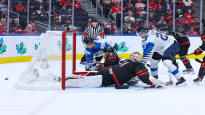According to Urheilu’s expert Topi Nättinen, Finland was weak against Canada. The starting group didn’t show any promise for the playoffs.
Finland’s under-20 national ice hockey team lost to host Canada in the last match of the opening group of the World Cup tournament with 3–6 goals. Sports expert Top Nättinen highlights three highlights from the situation of the Young Lions.
1. Finland is weak in the game
The Young Lions seemed ready in the first minutes of the match. However, it soon became clear that the Young Lions cannot meet Canada’s movement and level of demands.
According to Nättinen, Finland’s performance was a continuation of the three previous matches in the first group. Finland was better in terms of results, but the level of play was not high enough. The opponents were just weaker.
– Now, for the first time, there was a really tougher opponent and Finland couldn’t really get anything done except for the first five minutes. It even surprised me that the difference in level was so big, and the next level was not found in the mental side of this game either, says Nättinen.
Finland, especially in its own region, was in really big problems from time to time. The defenders couldn’t get out from under the pressure, and in addition, Finland fell into several mistakes.
– They were easy mistakes and all of them for top individuals. Canada made the first with a missile, but Topi Niemelä could have prevented it by playing harder and more precisely. In another Kasper Puutio slept and Canada struck with superiority. In Canada’s fourth goal Aatu Räty wasted his own player.
– Really common mistakes, which should not happen especially to these individuals. The mistakes were a little surprising. This was a very expected result, but somewhat worrying for the continuation.
2. Weak special situations
Finland was quiet in terms of play, but still got into the game in the final set as a result of Canada’s ice meltdown. Before the match, Finland’s superiority was the best in the tournament with 61.54 percent performance confidence.
Canada was also ahead in special situations. It struck from both overpowers and, despite its abundant ices, only allowed one underpowered goal.
– Finland played almost half of the third set with superiority. One goal was scored and the superiority percentage remained 16.67. It is unhelpfully too little. The understrength, on the other hand, was already weak and now it was even weaker, says Nättinen.
In addition to the loss against Canada, Finland had three wins from the opening group, including one in the winning goal competition. Although the game was not in order in the first group, Finland can learn from it. However, time is short.
– The initial group did not arouse promises, but Finland still has sufficient abilities to go no matter how far. From the next game onwards, however, things have to happen, says Nättinen.
If the empty net is taken out of the calculations, Canada scored five times against Finland. Before this, the Czech Republic and Slovakia each scored three goals in Finland’s net.
– The game doesn’t have to be great and great, but you can’t play on your own. You have to keep the allowed ones to a minimum and maintain that good superiority, and Finland will be close to a medal. You really have to learn from the preliminary group and especially from the Canadian match, what it takes to fight for a medal.
